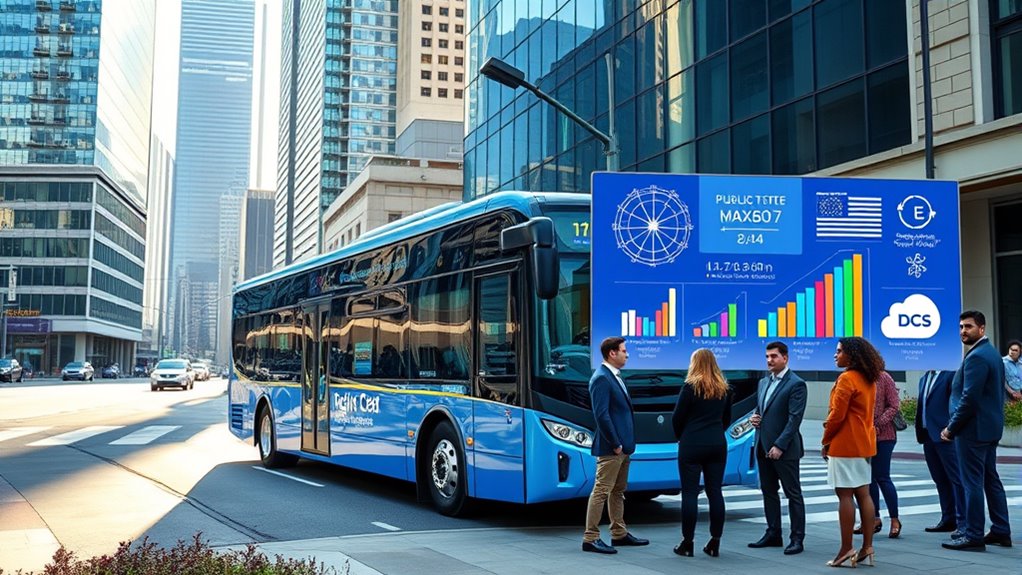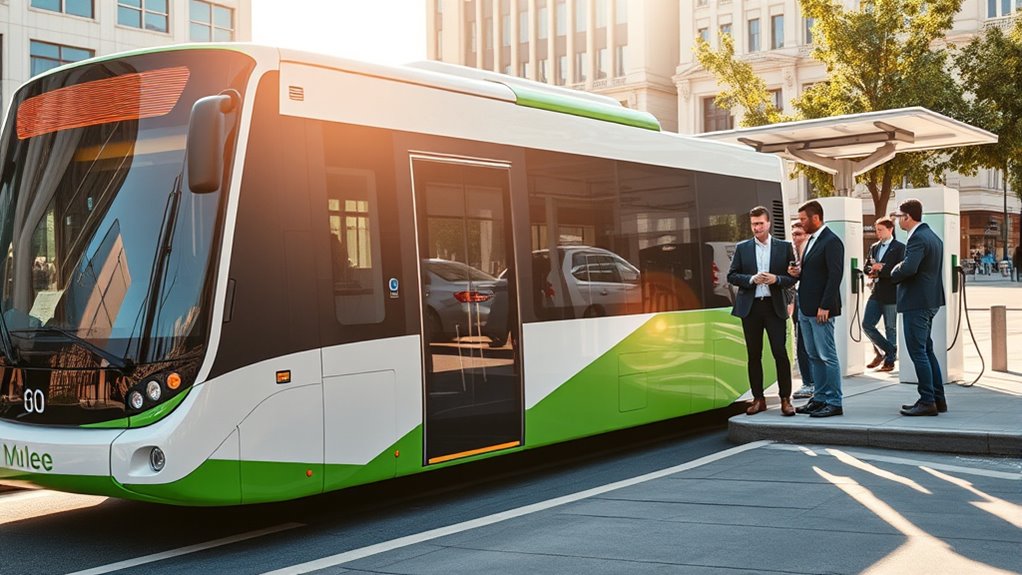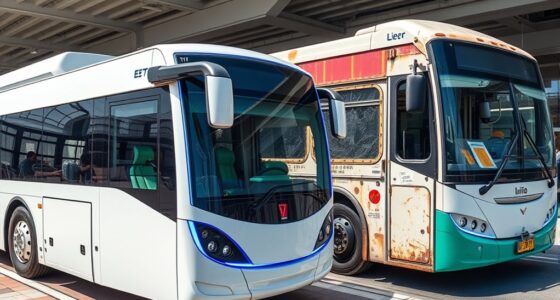Public-private partnerships (PPPs) are key to financing electric buses by combining private investment, expertise, and public funding. They establish frameworks for procurement, infrastructure development, and operational management, sharing risks and costs. PPPs often use leasing arrangements, performance-based contracts, and revenue-sharing models to guarantee sustainable funding. These collaborations streamline deployment and reduce government expenditure. To discover more about how PPPs can power your electric bus projects, keep exploring the various strategies and benefits involved.
Key Takeaways
- PPPs combine private investment and public funding to finance electric bus procurement and infrastructure development effectively.
- Long-term contracts with performance benchmarks secure revenue streams and incentivize environmental and operational goals.
- Public-private arrangements leverage subsidies, leasing models, and risk-sharing to reduce upfront costs for municipalities.
- Private partners manage charging infrastructure, depot upgrades, and smart grid integration to optimize energy use and costs.
- Phased implementation and workforce training ensure smooth transition and operational readiness of electric bus fleets.

Are public-private partnerships (PPPs) the key to accelerating the adoption of electric buses? They certainly play a vital role by creating a structured framework that combines resources, expertise, and financing to overcome common barriers. In this model, a new entity is often established to handle procurement, deployment, and ongoing maintenance. This dedicated organization streamlines processes, reduces costs, and ensures accountability.
Private funding covers the purchase of non-subsidized EV buses, while public financing supports the development of charging infrastructure. This split reduces the financial burden on municipalities and accelerates deployment. You’ll find that revenue streams are usually secured through pre-agreed payments from municipalities, which pay for the service of fleet electrification based on operational metrics like bus miles or service hours. These contracts often include performance benchmarks tied to greenhouse gas reduction goals, guaranteeing that investments deliver tangible environmental benefits.
When it comes to infrastructure, the PPP model emphasizes the installation of charging stations as a key responsibility of the managing entity. This includes converting existing bus depots to handle increased power demands, designing build contracts for depot electrification, and tailoring charging networks to fit operational schedules—such as overnight charging during off-peak hours. Additionally, innovative grid management solutions can be integrated to optimize energy usage and further reduce operational costs through smart grid integration.
Grid upgrades are also part of the plan, supporting high-density charging hubs and ensuring reliable power supply. You’ll see private partners, like energy companies or bus manufacturers, involved in deploying managed charging services that optimize energy costs and balance grid loads. These services often include usage-based pricing, making the system more efficient and cost-effective.
Financial mechanisms within PPPs are designed to reduce upfront costs and manage risks. Subsidies are allocated specifically for infrastructure development, and leasing models help municipalities avoid large capital expenditures. Long-term service agreements provide predictable cash flow, while risk-sharing arrangements mitigate concerns about technological obsolescence.
For example, private companies like Highland Electric secure financing for EV procurement and offer managed charging as a service, relieving municipalities from complex capital investments. These strategies foster confidence among stakeholders, ensuring sustainable and scalable deployment.
Additionally, selecting proven electric bus technology can further enhance project success by leveraging reliable performance standards established in the industry. Implementation strategies typically involve phased replacement of diesel buses, starting with pilot programs to validate infrastructure and operational capacity. Depot electrification often precedes full fleet transition, as seen in Bangkok and other regions.
Workforce training is integrated into maintenance contracts to ensure ongoing operational readiness. Monitoring systems, including IoT-based battery health management and fleet performance dashboards, enable proactive maintenance and continuous improvement.
Frequently Asked Questions
How Are Risks Shared Between Public and Private Partners?
You see risk sharing as dividing responsibilities to guarantee project stability. You understand private partners usually handle financial and operational risks like costs and revenue issues, while public partners manage operational, regulatory, and environmental risks.
Both collaborate on regulatory compliance and environmental concerns. This division helps you reduce costs, transfer expertise, and improve efficiency, ultimately making the project more resilient and aligned with sustainability goals.
What Are the Long-Term Maintenance Responsibilities?
Think of long-term maintenance as tending a garden—you need regular care to keep everything thriving. Your responsibilities include scheduling annual maintenance, handling repairs with trained technicians, and ensuring charging infrastructure stays operational.
You’ll also rely on warranties and manufacturer support, while developing local expertise. By planning ahead, you guarantee the electric bus fleet remains reliable, just like a well-tended garden that blooms year-round with consistent attention.
How Is Fare Revenue Allocated in PPP Agreements?
You should understand that in PPP agreements, fare revenue is typically collected by the public sector, but the allocation depends on the contract terms.
Sometimes, revenue is shared with private partners based on predefined ratios, or private operators may receive performance-based payments instead of direct fare revenue.
These arrangements aim to balance operational costs and incentivize quality service, with revenue sharing models supporting both public and private sector interests.
What Incentives Encourage Private Sector Investment?
You’re encouraged to invest in electric buses through several incentives. Governments offer financial support, grants, and tax benefits that lower your costs.
Regulatory policies like low-emission zones and infrastructure assistance make adoption easier.
Operational perks, such as reduced electricity rates, also boost profitability.
Stable policies and long-term commitments provide a predictable environment, making it more attractive for you to commit to electric bus projects and benefit from sustainable transportation initiatives.
How Do PPPS Impact Transit Service Quality?
When it comes to transit service quality, PPPs really hit the mark. They bring in private sector expertise, leading to more efficient operations, innovative tech, and better maintenance.
You’ll notice improved reliability, punctuality, and customer satisfaction, as competition pushes providers to excel. Plus, risk sharing ensures smoother service.
All these factors work together to turn transit into a well-oiled machine, making your rides more comfortable, dependable, and enjoyable.
Conclusion
Think of public-private partnerships as the engine powering the future of electric buses. By working together, you can turn the wheels of innovation and sustainability, driving your community toward cleaner transportation. These collaborations are like a well-tuned engine—when all parts work in harmony, progress accelerates smoothly. Embrace this partnership, and you’ll find yourself steering toward a greener, more efficient future, where every mile traveled is a step closer to a healthier planet.









